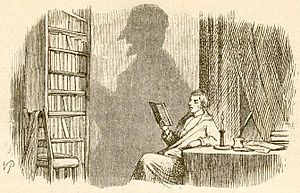The Shadow (fairy tale) facts for kids

Vilhelm Pedersen illustration
|
|
| Author | Hans Christian Andersen |
|---|---|
| Original title | Danish: Skyggen |
| Country | Denmark |
| Language | Danish |
| Genre | Literary fairy tale |
|
Publication date
|
1847 |
The Shadow (Danish: Skyggen) is a famous fairy tale written by the Danish author Hans Christian Andersen. It was first published in 1847. This story explores what happens when a person's shadow gains a life of its own.
Contents
Story of The Shadow
The Man and His Lost Shadow
A smart man from northern Europe traveled to a warm country. One night, he sat on his balcony. The fire behind him made his shadow stretch onto the building across the street. He thought it was funny how his shadow moved with him. It looked like his shadow was sitting on the other balcony too!
When he went to sleep, he imagined his shadow would go inside the other house. But the next morning, he woke up and found his shadow was gone! A new, tiny shadow slowly grew back from his feet. The man didn't think much more about it. He went back home and started writing again.
The Shadow Returns
Years later, his old shadow knocked on his door. It looked almost like a real person! The man was very surprised and invited the shadow inside. They sat by the fireplace, and the shadow told him how it had become human.
The man was kind and gentle. He loved to write about good, beautiful, and true things. But no one else seemed to care about his writings. The shadow, however, said the man didn't understand the world. The shadow claimed it had seen how truly unkind some people could be.
A Strange Swap
Over the years, the shadow became rich and powerful. Meanwhile, the writer grew poorer and weaker. He became so ill that his former shadow offered to pay for a trip to a health resort. But there was a strange condition. The shadow wanted to act as the master, and the writer had to pretend to be his shadow.
This idea sounded very silly, but the sick man finally agreed. They went on the trip, with the shadow now acting as the master. At the resort, the shadow met a beautiful princess. They danced and talked every night, and the princess fell in love with the shadow.
The Shadow's Plan
When the shadow and the princess were about to get married, the shadow offered his former master a fancy job at the palace. But again, there was a condition: the writer had to become the shadow's shadow forever. The writer immediately said no. He threatened to tell the princess everything.
But the shadow had the writer arrested. The shadow then pretended to be very upset when he spoke to the princess. He told her:
"I've had the most terrible thing happen! My shadow has gone crazy. I guess a small, weak mind can't handle much. He thinks he's a real person, and that I am his shadow!"
"How terrible!" cried the princess. "Is he locked up?"
"Oh yes, he is," said the shadow. "I'm afraid he'll never get better."
"Poor shadow!" said the princess. "It's very sad for him. It would be a kind thing to end his difficult life. And when I think about how people sometimes side with the lower class against the higher class these days, it might be smart to quietly get rid of him."
Later that night, when the shadow married the princess, he found out that the man was no longer there.
When The Shadow Was Published
"The Shadow" was first published on April 6, 1847. It was part of a collection called New Fairy Tales. Second Volume. First Collection. 1847. The story was published again in December 1847 in A Christmas Greeting to my English Friends. It also appeared in other collections later on.
Other Shadow Stories
About 30 years before Andersen wrote "The Shadow," a story called "Peter Schlemihl's Miraculous Story" was published in 1814. It was written by Adelbert von Chamisso. That story was about a man who sold his shadow to the devil for a magic wallet.
Andersen's story was inspired by Chamisso's. He even mentions it in "The Shadow":
He was very annoyed, not so much because the shadow had disappeared, but because he knew there was a story. Everyone in the cold countries knew about a man without a shadow. If he went back now and told his own story, they would surely say he was just copying. And that was the last thing he wanted.
Andersen's story also seems to have influenced "The Fisherman and His Soul" by Oscar Wilde.
The Shadow in Other Art
Books and Plays
- The Shadow was the first long story to be published in Esperanto. This was in 1888 in the book Dua Libro by L. L. Zamenhof, who created the Esperanto language.
- Evgeny Shvarts wrote a play called Tyen (The Shadow). It was based on Andersen's tale but added new characters and a different ending.
Radio and Music
- In 1945, the story was made into an episode of the radio show The Weird Circle.
- In 1994, Frederik Magle, Thomas Eje, and Niels-Henning Ørsted Pedersen released an album called The Song Is a Fairytale. It had songs based on Hans Christian Andersen's fairy tales, and "The Shadow" was one of them.
Ballet
- Skuggaleikur (Shadow Play) is an opera by Icelandic composer Karólína Eiríksdóttir. It premiered in November 2006.
- In 2003, the Carolina Ballet performed a ballet version of The Shadow. The dance was created by Robert Weiss. The music included pieces by Khachaturian, Kabalevsky, and others. In the ballet, there's a scene where the poet looks at his shadow in a mirror. The shadow, which first copies his moves, then seems to step out of the mirror as another dancer.

